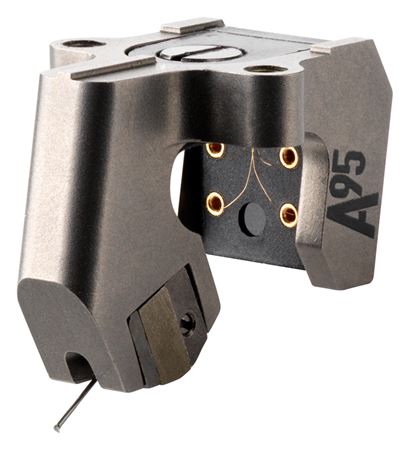


These are the questions we attempt to answer on this page.
❝ Which is the best cartridge to use when making needle-drops? Should I buy a moving-magnet or a moving-coil type? What type is best for mono records?❞
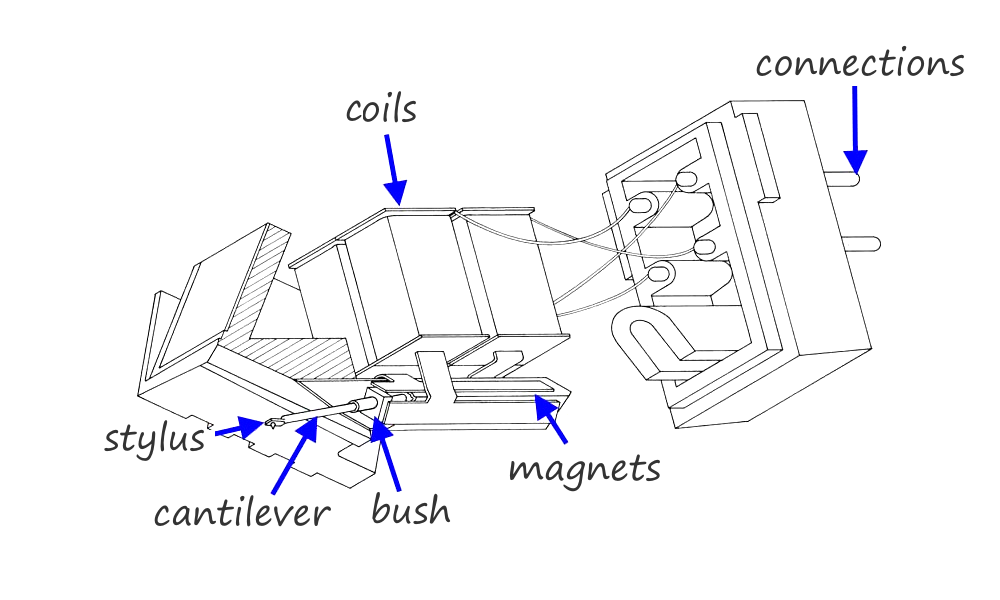
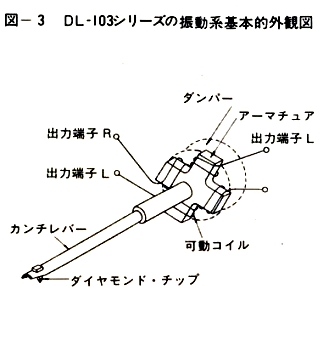 When a phonograph record is played, the stylus traces the wiggly grooves and the assembly is arranged so that the movements of the stylus are communicated via the cantilever to move a coil and a magnet relative to one another — thereby generating a small electric current according to Faraday's law.
When a phonograph record is played, the stylus traces the wiggly grooves and the assembly is arranged so that the movements of the stylus are communicated via the cantilever to move a coil and a magnet relative to one another — thereby generating a small electric current according to Faraday's law.
Now there's clearly a choice here. Either the cantilever moves a small magnet near a coil, in which case the cartridge is termed a moving-magnet type (illustrated left): or, very small coils are contrived to move in a magnetic field (right), in which case the cartridge is called a moving-coil type. In a stereo cartridge, there are two circuits, and two magnets, one for each channel10.
The performance of any phono cartridge ultimately relies on the stylus' ability to remain in contact with the walls of the groove. This is referred to as the cartridge's ability to track the groove. A greater part of this accomplishment lies in the design of the moving part of the cartridge which must be made as light as possible (especially its inertial effect at the stylus point). We compare moving-magnet and moving-coil tracking in Appendix 2.
The challenge for either type is that in the moving-magnet catridge, the stylus must move a (relatively) heavy magnet and, in the moving-coil type, the stylus must must move a (relatively) heavy coil.
The disadvantage of the moving-magnet type may be offset by selecting a small magnet but increasing the size of the coils. If you take apart a modern moving-magnet cartridge you will discover two (for stereo) very small magnets and two substantial coils; each of very many turns of fine wire (right).
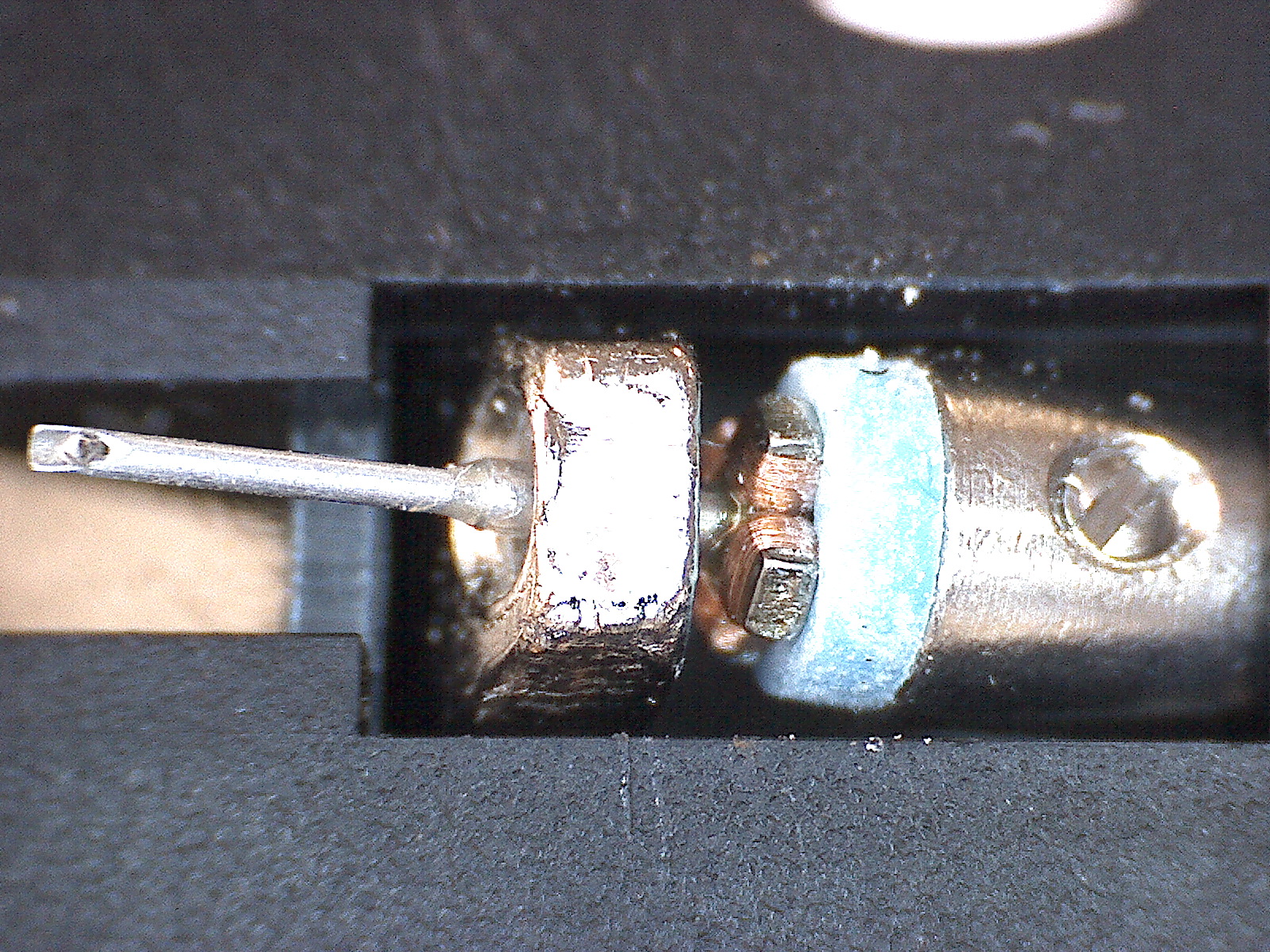 Looking at Faraday's Law, we can see that this approach to design trades off the term for the strength of the magnetic flux (ΦB) against the term for the size and complexity of the coil (k) to keep the generated voltage (E) as high as possible.
Looking at Faraday's Law, we can see that this approach to design trades off the term for the strength of the magnetic flux (ΦB) against the term for the size and complexity of the coil (k) to keep the generated voltage (E) as high as possible.
Obviously, if the coils of a moving-magnet cartridge were physically connected to the cantilever of a moving-coil type, the result would be disastrous: the moving-mass would be huge and would result in awful tracking.
So, in the moving-coil cartridge the coils are made as small as possible, with just a few turns of wire (k is small, see Magnetism and Electricity). The coils of the famous Denon DL-103 moving-coil cartridge are illustrated left.
To compensate for the low k, the magnet is made as strong as possible (to maximise ΦB) and thereby enhance E.
However, in order to keep the moving-mass down to acceptable levels, the moving-coil type cartridge is an order of magnitude less efficient than the moving-magnet type and practical cartridges generate a very low output signal (compared with moving-magnet types).
This is why moving-coil cartridges require a special head-amplifier or transformer stage before the signal can be fed to a normal phono preamplifier.
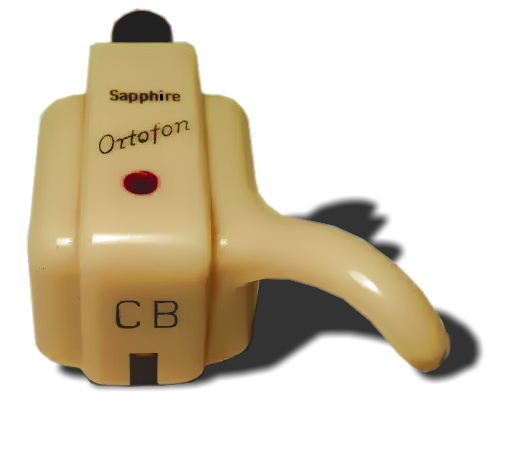 Most vinyl-record enthusiasts share a belief that the more expensive moving-coil (MC) type cartridges outperform the moving-magnet (MM) type ³.
Most vinyl-record enthusiasts share a belief that the more expensive moving-coil (MC) type cartridges outperform the moving-magnet (MM) type ³.
In truth, this is a simplification. Market competition was so fierce during the period when records were a mass-market commodity that all the margin was squeezed out of the more popular moving-magnet type cartridge leaving the moving-coil models as the only product in which manufacturers could invest in the hope of a reasonable return.
There is no technical reason why a moving-magnet type cartridge would not benefit from advanced cantilever technology and new stylus profiles and, even more, from improvements in the electrical generator. But history has forced the moving-magnet to dominate the lower-end of the cartridge market leaving moving-coils to remain unchallenged at the top-end. And that has constrained the last half-century of innovation to the moving-coils.12
It was not always so. In the 1950s, ceramic (crystal) cartridges were the norm in the home and moving-coil cartridges were standard in broadcasting and in other high-quality applications.
It was considered a very great step forward when the American cartridge manufacturer Shure Brothers Inc., who did so much to put the design of phono catridges on a rational basis, introduced the first moving-magnet cartridge12, 13. As Ben Bauer explains in a paper6 describing the development of the phono cartridge,
❝....By devising a moving-magnet pickup, in which the traditional roles of armature and magnet were reversed, it became possible to lower the ..... stylus bearing force.. [to] one-gram. [The first time this was] achieved in a practical, commercial device... Its tracking capability set a new standard which has not been exceeded to this very day.❞
It's instructive to create a little table with the pros and cons of moving-magnet and moving-coil cartridges.
| MM Advantages | MM Disadvantages |
|---|---|
|
- Possibly lightest armature ➪ for good tracking - Connection to static stator - Efficient (simpler preamp') - Easy to manufacture (lower cost) |
- Inductive (and high) impedance ➪ Worse crosstalk ➪ Worse noise ➪ Unpredictable frequency response |
| MC Advantages | MC Disadvantages |
| - Low (and resistive) impedance ➪ Better crosstalk ➪ Better noise ➪ Better frequency response |
- Possibly heavier armature ➪ more difficult for good tracking - Connection to moving armature - Inefficient (more complex preamp') - Difficult to manufacture (higher cost) |
Tabulated in this way, it's clear to see that the moving-magnet type has significant mechanical and commercial advantages over the moving-coil type, but significant electrical disadvantages.
The moving-magnet cartridge struggles to provide the signal quality from a moving-coil type once it is interconnected into a system. The electrical generator is not at fault. Faraday's law shows us there there is nothing inherently better about which part - magnet or coil, moves relative to the other4. However, the magnetic field strength, and hence sensitivity, of the moving-magnet transducer is limited by saturation of the armature or the pole pieces and by the negative compliance due to the pull of the steady magnetic field on the armature.
If the field exceeds a critical value determined by the static compliance of the armature restoring force it will result in the armature being attracted to one of the pole faces. It is this negative compliance which generally limits the sensitivity of the MM pickup; requiring coils of several thousand turns of fine gauge wire to produce usable output.
These many thousands of turns of wire determine the source impedance of the moving-magnet type pickup which rises with frequency. This creates a number of practical problems when connected to the outside world.
The moving-coil pickup suffers none of the disadvantages listed above. If the magnetic field is linear (and this condition is not difficult to achieve) the electrical output is strictly a function of coil velocity. Because of the absence of negative compliance the magnetic field can be increased to the limit and field strengths 100 times more powerful than employed in the moving-magnet type are possible; the signal to noise ratio being improved proportionately.
Listing the electrical disadvantages of the moving-magnet type cartridge (as we did above) makes for a formidable list!. However, in one respect at least moving-magnet cartridges are easy to work with - they have a very standardised output level. Virtually all moving magnet cartridges output around 5mV at a recorded velocity of 5cm/s ±30%. which makes the choice of preamplifier uncomplicated.
For the best results with Stereo Lab, the preamplifier must be non-equalising or "flat". This page describes suitable preamplifiers.

The electrical disadvantages of the moving-magnet pickup may be eliminated by means of a lightweight, electronic amplifier close to (or inside) the cartridge itself. Using this technique, it is possible to secure an electrical performance from the moving-magnet type pickup which matches the moving-coil type at lower cost.
Our sister company Phædrus Audio developed this idea into the PHLUX Active phono cartridge which is available as a commercial product. Combined with PHLUX-II correction in Stereo Lab, this active fixed-coil cartridge is capable of performance of unparalleled accuracy.
Several solutions for flat-response preamplifiers with active powering for the PHLUX-II exist.
Using moving-coil cartridges with Stereo Lab
Given that - for the reasons given above - the higher eschelons of the phono cartridge market are reserved for moving-coil cartridges, we surely want to be able to use this type for needle-drops and Stereo Lab processing.
A flat preamplifier is required and our own, laboratory standard solutions are summarised on this page.
Below is a series of recommended hardware solutions for a list of contemporary moving-coil phono cartridges.
The cartridge lists are recommended with the following hardware solutions based on output levels and load impedance requirements. Cartridges appear more than once where they work equally well with different hardware.
Audio Technica AT-ART9, AT-33Sa, AT-OC9XSL,AT-OC9XSH, AT-OC9XML, AT-OC9XEN, AT-OC9XEB, AT-33PTG/II, AT-33EV, AT-ART1000
Benz Micro ACE S Low (Red Body), MC Gold
Clearaudio Talisman V2 Gold, Essence
Denon DL103, DL103 R EM
Dynavector DV XX2 MKII, DV-20 X2 (low-output), DR XV1-S, DRT XV-1T, Karat 17DX, Te Kaitora Rua
Gold Note Tuscany Gold
Goldring Ethos, Elite
Koetsu Urushi Gold, Urushi Sky Gold, Urushi Tsugaru, Urushi Black, Red T, Black K, Azule Platinum, Blood Stone Platinum, Blue Onyx Platinum, Burma Jade Platinum, Rhodonite Platinum, Jade Platinum, Signature Rosewood
Lyra Kleos, Atlas Lambda SL, Etna Lambda SL, Kleos SL
Ortofon Cadenza: Blue, Red, Bronze, Black: Quintet Blue, Red, Bronze, Black: MC Anna (Diamond), SPU, MC Windfeld Ti
Rega Aphelion 2, Ania Pro, Ania
Roksan Shiraz
Shelter Harmony, Accord, Model 901 III, Model 5000, Model 501 II, Model 301 II
Shun Mook Reference
Sumiko Palo Santos Clebration, Pearwood Clebration, Starling, Blue Point Special EVO III
Audio Technica AT-ART9, AT-33Sa, AT-OC9XSL, AT-OC9XSH, AT-OC9XML
Benz Micro ACE S Medium (clear body), Gulwing SHR, ACE S Low (red Body), MC Gold
Clearaudio Goldfinger Statement, Titanium V2, Da Vinci V2, Stradivari, Concerto V2, Talisman V2 Gold, Essence
Gold Note Donaltello Gold, Machiavelli Gold Mk 2
Goldring Ethos, Elite
Koetsu Red K, Urushi Gold, Urushi Sky Gold, Urushi Tsugaru, Urushi Black, Red T, Black K
Lyra Delos, Atlas Lambda, Etna Lambda, Kleos
Ortofon Cadenza Red, Cadenza Blue, Cadenza Bronze, Quintet Blue, Quintet Red
Shelter Model 9000, Model 7000, Harmony, Accord, Model 901 III, Model 5000, Model 501 II, Model 301 II
Soundsmith Sussurro MK II, Hyperion MK II, Paua MK II, Zephir‡
Shun Mook Reference
Sumiko Blackbird Low, Palo Santos Clebration, Pearwood Clebration, Starling, Blue Point Special EVO III
Van den Hul White Beauty Special X, The Crimson, The Frog (standard & Gold), MC-One Special, MC-10 Special, Grasshopper III (GLA), Grasshopper III (SLA), The Canary, Black Beauty GPX, Condor Gold high out, Condor (standard and high out)
Denon DL110
Benz Micro ACE S Medium (clear body), ACE S High (blue body), Ebony S (high)
EMT HSD006, JSD 5, JSD 6, JSD P 6.0 Platinum, JSD Pure Black, JSD Pure Lime, JSD S 75, EMT JSD VM
Grado Statement 3, Opus 3 (Low), Sonata 3 (Low), Platinum 3 (Low), Reference 3, Master 3 (Low)†
Benz Micro ACE S High (blue body), Ebony S (high), MC Silver
Dynavector DV-10X5 MK11 (high-output), DV-20 X2 (high-output)
Gold Note Donatello Red
Goldring Eroica H (high out)
Ortofon MC-1 Turbo & MC-3 Turbo
Sumiko Blackbird High, Songbird High, Amethyst, Blue Point Special EVO III, Blue Point No. 2 High Out
Van den Hul White Beauty Special XO, Grasshopper III (high out), The Frog (High output), MC-Two Special, Black Beauty GPX (High)
Audio Technica AT-ART9
Benz Micro ACE S High (blue body), Ebony S (High), MC Silver, ACE S Medium (clear body), Gulwing SHR
Clearaudio Goldfinger Statement, Titanium V2, Da Vinci V2, Stradivari, Concerto V2, Talisman V2 Gold
Denon DL110EM
Dynavector DV-10X5 MK11 (high-output), DV-20 X2 (high-output)
EMT HSD006, JSD 5, JSD 6, JSD P 6.0 Platinum, JSD Pure Black, JSD Pure Lime, JSD S 75, EMT JSD VM
Gold Note Donatello Red, Machiavelli Red Mk 2, Donaltello Gold
Goldring Eroica H (High Out), Ethos, Elite
Grado Statement 3, Opus 3 (Low), Sonata 3 (Low), Platinum 3 (Low), Reference 3, Master 3 (Low)
Koetsu Red K
Lyra Delos, Atlas Lambda, Etna Lambda, Kleos
Ortofon MC-1 Turbo & MC-3 Turbo, Cadenza Blue, Quintet Blue, Quintet Red
Shelter Model 9000, Model 7000, Harmony, Accord, Model 901 III, Model 5000, Model 501 II
Soundsmith Sussurro MK II, Hyperion MK II, Paua MK II, Zephir‡
Sumiko Blackbird High, Songbird High, Amethyst, Blue Point Special EVO III, Blue Point No. 2 High Out, Blackbird Low, Palo Santos Clebration, Pearwood Clebration, Starling, Blue Point Special EVO III
Van den Hul White Beauty Special XO, Grasshopper III (high out), The Frog (High output), MC-Two Special, Black Beauty GPX (High), Black Beauty GPX (Medium), White Beauty Special X, The Crimson, The Frog (standard & Gold), MC-One Special, MC-10 Special, Grasshopper III (GLA), Grasshopper III (SLA), The Canary, Black Beauty GPX Standard, Condor Gold high out, White Beauty Special X, Condor Standard, high out
† The low output Grado's (not MCs in fact, but with 1mV @ 5cm/s output) are specified into a higher input impedance, but they have been tested and work well with TRANSFORMER 3. Primary inductance is sufficient to give a bass response which is -3dB at 5Hz and the inherent source inductance of the Grado's is low enough to restrict HF loss to 1dB at 20kHz.
‡ Low-output moving iron types
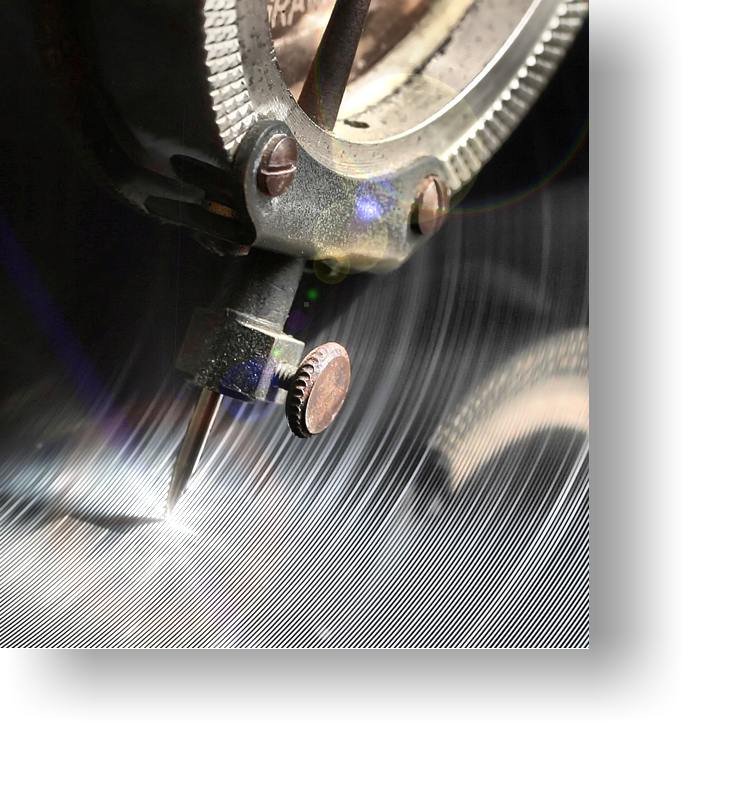 A mono gramophone (phonograph) record captures the music in side to side (lateral) modulations of the groove. This is retained in a stereo record, but the extra stereo (channel-difference) information is modulated by supplementing the side to side "wiggles" of the mono signal with up-and-down (vertical) stylus movements. The diagram below illustrates the concept.
A mono gramophone (phonograph) record captures the music in side to side (lateral) modulations of the groove. This is retained in a stereo record, but the extra stereo (channel-difference) information is modulated by supplementing the side to side "wiggles" of the mono signal with up-and-down (vertical) stylus movements. The diagram below illustrates the concept.
Another way to formalise this is to say that the inner groove-wall carries the left-channel information, and the outer groove-wall carries the right-channel information.
The interest in historic, monaural recordings on vinyl and shellac records has prompted several phono-cartridge manufacturers to release mono phono-cartridges. Some models are even specialised for 78 RPM records. With larger styli and limited frequency response, these low-compliance cartridges can track with a greater down-force than a conventional cartridge and thus are designed to respond only to lateral modulation.
For simple listening pleasure in a purist, all-analogue set-up, these cartridges represent a fine investment. But they are sub-optimal for needle-drops intended for Stereo Lab.
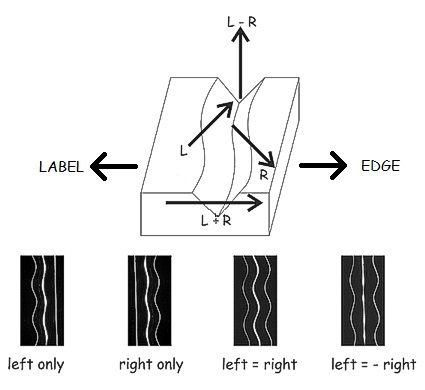
Because we can say that the left and right signals on a stereo LP are carried in the left- and right-hand walls of the V-shaped groove, we can equally say that, in a mono record, the same information (the mono signal) is carried twice. A mono disc has thereby a built-in 100% redundancy in its encoding of the original signal.
A mono gramophone record can be thought of as RAID 1 hard-drive!
Inside the DSP of Stereo Lab we use this informational redundancy to advantage. For example, it helps us detect where groove damage has occured and how to conceal it, and it plays a significant role in the detection and correction of geometrical distortion mechanisms. We also use this redundancy to analyse statisically the difference (left minus right) signal for its peak and RMS values which tells us a great deal about the condition of the disc and permits us to set various parameters automatically.
A specialised mono cartridge simply scans the two signals from the left-hand wall and from the right-hand wall and generates a signal which is the geometrical average of the two inscribed modulations. In so doing, the redundancy is lost .
Counterintuitively, we therefore recommend a STEREO cartridge for all historic, mono needle-drops.

Working in the early part of the nineteenth century, Ørsted noticed that, when electricity flowed in a wire, it created a magnetic field which could be detected by a small magnetic compass. Later, it was dicovered that, if the wire was wound into a coil, it greatly increased the magnetic effect.
Michael Faraday (left) reasoned that if electricity could cause magnetism, then it ought to be possible to transform magnetism into electricity. So he wound a coil of wire and experimented with a magnet to see if he could detect any current induced into the coil of wire.
He noticed that, only when he moved the magnet near the coil, did a current flow in the coil of wire. If the magnet was held still, no current was induced. That’s the crucial point: electricity will create magnetism but only changing magnetism will make electricity¹.
James Clerk Maxwell formalised Faraday's discovery into what is now called Faraday's law which is written like this,
where E is the electromotive force, ΦB is the magnetic flux, and k is a negative constant which also incorporates the number of turns in the coil. The d(x)/dt part just means, the rate of change with time.
So E (the electromotive force, or voltage) generated in the coil relies on three things: the strength of the magnetic flux (ΦB); the speed (velocity) with which the flux changes (d(ΦB)/dt); and the construction of the coil, especially the number of turns of wire in the coil (k).
J. Walton (an important worker in the field back in the 1960s and 70s) had this to say about the design of phono cartridges5.
❝ ... trackability [is] the first essential in gramophone pickup performance.. - that is, the continuous and consistent contact between stylus and groove wall ...❞
![]() We dislike the term trackability. It's so 1970s: you can almost sense the synthetic fibres and bell-bottoms! We prefer to think in modern data-processing terms which means we can consider poor tracking as read errors.
We dislike the term trackability. It's so 1970s: you can almost sense the synthetic fibres and bell-bottoms! We prefer to think in modern data-processing terms which means we can consider poor tracking as read errors.
There's a parallel between a head crash in a digital hard-drive and a loss of tracking in an analogue phonograph disc. In the former, a failure occurs when the read–write head comes in contact with its rotating platter, resulting in permanent and usually irreparable damage to the platter surface. In the case of a phono cartridge, a failure occurs when the stylus loses contact with the rotating medium. But the results are the same! As Frank Karlov of Shure put it, ²
❝ ........ many feel that only a few of the more highly modulated records require [good trackability]. This is probably because most mistracking occurs when playing transient signals and is of such short duration that it is not perceived and identified as mistracking...... The sound quality, however, may be destroyed as well as the record groove.....❞
Which cartridge type tracks best?
Seeing "trackability" in terms of (possibly permanent) data loss raises what seems to be a rather esoteric issue to centre-stage — certainly for the archivist. So, we embarked upon a more serious and fundamental study of various types and models of phono cartridge to investigate their tracking performance. This involved developing our own tests and developing an understanding why tracking must be tested across the whole audio frequency band.
![]()
In addition, we looked at tracking performance data from a series of technical reviews of commercial cartridges published by Hi-Fi World magazine8. These tests were all performed by Noel Keywood who has had many years experience reviewing phono cartridges and has developed measurements which probe tracking performance at low-frequencies and mid-frequencies. Without this crucial mid-frequency test, which is often ommited by other reviewers, tracking test data is relatively meaningless.
From an analysis of Noel's Hi Fi World test data, we derived an overall tracking-performance merit figure 9 which was plotted against unit price to obtain the curve given (left). The initial points on the curve (marked with red squares) relate to the measurements of moving-magnet cartridges, the remaining points are tracking data relating to moving-coils. Note that the price axis is very non-linear: the difference in cost between the cheapest cartridge reviewed and the most expensive is over 100 times!
A linear trendline was derived (red) and rather depressingly does indicate a decline of "trackability" with price. A polynomial curve fit (green) illustrates the situation is more complicated. However, it's abundantly clear that the moving-magnet group at the lower end of the market help maintain strong tracking scores in this price-range, and the variable performance in the moving-coil group account for the decay in performance with price increase11.
The results of our own tests and the study of the data from Hi Fi World technical reviews confirms that moving-coil cartridges do not (as a general rule) outperform moving-magnet types in terms of tracking. The moral for the vinyl enthusiast, record-collector or archivist is therefore equivocal.
If the budget allows for a moving-coil type cartridge which will certainly offer the best electrical performance, try to make sure that there is some third-party verification of tracking performance, as in the Hi Fi World articles quoted here. Alternatively, do your own tracking tests. It appears that price alone is no guarantee of good tracking.
The literature review suggests moving-magnet cartridges will normally deliver good tracking performance due to the simpler construction of this type of transducer11. But the electrical disadvantages of the moving-magnet cartridge will set a lower bound on noise and introduce variability into frequency and phase response due to its interaction with cables and preamplifier.
Our own solution to this dilemma is explained in the section on the active PHLUX cartridge.
1. You may think it's odd for Nature to build in such an apparent asymmetry. In fact, it is not the case. An electric charge (an electron) in motion is a current and it is that which creates the magnetic field. So, moving charges create a magnetic field and moving (changing) magnetic fields create a current.
2. High Fidelity Phonograph Cartridge - Shure Technical Seminar NYC 1978. Available from Shure.
3. The 8 best turntable cartridges to achieve ultimate sound quality Rigby, P. ,from which this quote is a good example of the orthodoxy,
❝ ...... two principle technologies power [phono cartridges]: Moving Magnet (MM) or Moving Coil (MC). In broad terms, the latter is of a more advanced design than the former and is, therefore, more expensive to buy. Both cartridge designs can sound excellent but the moving-coil variant has the ability to go one step further and reach audiophile heights.❞
https://thevinylfactory.com/features/the-8-best-turntable-cartridges-to-achieve-ultimate-sound-quality/
4. Measured distortion generated by the [moving-magnet] transducing mechanism is as low or lower than from any other practical transducing mechanism known. We have performed extensive tests to determine whether distortion is created within the magnetic assembly or as a result of any undesirable motions of the transducer such as axially along the groove. We have never been able to measure any distortion from these sources nor has anyone else ever provided definitive tests which would indicate that such distortion is present to a measurable degree. (Reference. 2)
5. Measuring Gramophone Pickup Performance, J. Walton WIRELESS WORLD, DECEMBER 1967
6. The High-Fidelity Phonograph Transducer Bauer, B. JAES October/November 1977, Volume25, Number10/11
7. Handbook for Sound Engineers (Audio Engineering Society Presents) Ballou, G. (ed.) 5th. edition CRC Press, 2015
8. Available at: https://www.hi-fiworld.co.uk/index.php/vinyl-lp/25-cartridges.html
9. The overall figure of merit for tracking was derived by taking the numerical value for maximum lateral excursion handling (in peak µm) plus four times the value (in cm/s) of the maximum handling of lateral velocity at 1kHz. The four times figure was included to equalise the contribution of the lateral figure (best = 90µm) with mid-frequency velocity (best = 25cm/s). A bias value of 127 was then subtracted from this figure to normalise the worst in the group to a score of zero. The maximum value for the handling of vertical velocity at 300Hz was ignored as all units scored 45µm and thus it added nothing to a comparative measure.
10. The enemy of all magnetic pickups is hum and all practical designs use humbucking to bias the pickup towards transducing wanted signal and away from transducing stray hum fields. In the illustrations of both the moving-coil and the moving-magnet type cartridge each circuit (left or right channel) is very clearly made up to two coils - wound electrically in series - but arranged in magnetic opposition. Vibration will create a similar signal in both these coils, and these will add due to the series connection. But an external field will induce a signal of opposite phase in either coil, and these will cancel due to the series connection.
11. It may be that some of the explanation for the better tracking performance of models at the cheaper-end of the cartridge price-range is due to the simpler stylus designs at this price-point. The profile of a stylus may be regarded as a physical acceleration limiter. The elastomer bearing which supports the stylus and cantilever of the cartridge needs to have been correctly designed to cope the extra deflection which the finer stylus profile affords at high-frequencies. If it hasn't, the result is worse tracking.
12. Shure Brothers Inc. remained adamant supporters of the moving-magnet cartridge type. In a Q&A section of a technical seminar in New York in 1978, the Shure team replied to the question, "Why did Shure select the moving magnet transducer for the V15 Type IV?" in this way,
❝....we periodically consider the advantages and disadvantages of all types of transducers. ....... we feel very strongly after careful consideration that there are many factors in favor of the selection of the moving magnet transducer. [Amongst] the advantages of this type of transducer are the effective mass of the transducing element is as low as any practical transducer, and its configuration is such as to allow a stylus design for high trackability. The fact that Shure cartridges have the highest trackability of any on the market is evidence of this fact.❞ ²
They go on to explain various, further advantages of the moving-magnet type: The use of extremely fine, fragile wire is avoided and the terminals connect to the static stator rather than the moving armature of the generator and thus are not required to flex which adds further mechanical complications4.
13. US Patent 3,055,988 Magnetic Phonograph Pickup. Filed April 1957: granted September 1962
 Home page
Home page
For all support issues, go here.
For Pspatial Audio sales, email: sales@pspatialaudio.com
